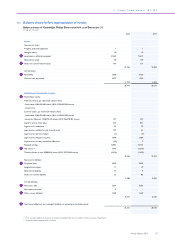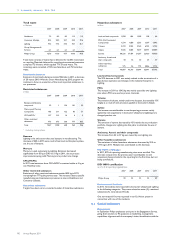Philips 2011 Annual Report Download - page 186
Download and view the complete annual report
Please find page 186 of the 2011 Philips annual report below. You can navigate through the pages in the report by either clicking on the pages listed below, or by using the keyword search tool below to find specific information within the annual report.
14 Sustainability statements 14 - 14.2
186 Annual Report 2011
Reporting on ISO 14001 certification is based on manufacturing units
reporting in EcoVision.
Operational carbon footprint
The Philips operational carbon footprint is calculated on a half-yearly
basis and includes:
• Industrial sites – manufacturing and assembly sites
• Non-industrial sites – offices, warehouses, IT centers and R&D
facilities
• Business travel – lease and rental cars and airplane travel
• Logistics – air, sea and road transport
All emission factors used to transform input data (for example, amount
of ton-kilometers transported) into CO2 emissions are from the
Greenhouse Gas Protocol (GHGP), except for business travel, where
the service providers supplied CO2 data based on their own verified
methodology. The GHGP distinguishes three scopes. It is mandatory
to report on the first two to comply with the GHGP reporting
standards.
• Scope 1 – direct CO2 emissions – is reported on with direct
emissions from our industrial and non-industrial sites in full.
Emissions from industrial sites, which consist of direct emissions
resulting from processes and fossil fuel combustion on site, are
reported in the EcoVision reporting system. Emissions from
industrial sites that are not yet reporting in EcoVision following
recent acquisitions are collected separately, or where actual data is
not available, calculated based on average CO2 emissions per square
meter of comparable sites in the same sector. Energy use and CO2
emissions from non-industrial sites are based on actual data where
available. If this is not the case, they are estimated based on square
meters, taking the geographical location and building type of the site
into account.
• Scope 2 – CO2 emissions resulting from the generation of purchased
electricity for our premises – is reported on with electricity use from
industrial and non-industrial sites in full. Indirect CO2 emissions
resulting from purchased electricity, steam and heat are reported in
the EcoVision reporting system. Those emissions of industrial sites
not yet reporting in EcoVision are calculated on the same basis as
described in Scope 1. Indirect emissions of non-industrial sites are
calculated in the same manner as described in Scope 1.
• Scope 3 – other CO2 emissions related to activities not owned or
controlled by the Group is reported on for our business travel and
distribution activities. Commuting by our employees, upstream
distribution (before suppliers ship to us), outsourced activities and
emissions resulting from product use by our customers are not
included in our operational carbon footprint. The calculations for
business travel by lease cars are based on actual fuel usage and for
rental cars on distance traveled. Emissions from business travel by
airplane are calculated by the supplier based on mileage flown and
emission factors from DEFRA (UK Department of Environment,
Food and Rural Affairs), distinguishing between short, medium and
long flights. Further, emissions from air freight for distribution are
calculated based on the amount of ton-kilometers transported
between airports (distinguishing between short, medium and long
hauls), including an estimate (based on actual data of the lanes with
the largest volumes) for trucking from sites and distribution centers
to airports and vice versa. Express shipments are generally a mix of
road and air transport, depending on the distance. Therefore the
assumption is applied that shipments over less than 600 km are
transported by road and the rest of the shipments by air (those
emissions by air are calculated in the same way as air freight). For
sea transport, only data on transported volume were available so an
estimate had to be made about the average weight of a container.
Transportation to and from ports is not registered. This fore and aft
part of sea transport was estimated to be around 3% of the total
distance (based on actual data of the lanes with the largest volumes),
consisting of a mix of modalities, and was added to the total
emissions accordingly. CO2 emissions from road transport were also
calculated based on ton-kilometers. If data were incomplete, the
emissions were estimated based on sales volumes. Return travel of
vehicles is not included in the data for sea and road distribution.
Health and safety
Health and safety data are reported monthly and validated on a half-
yearly basis. The focus is on reporting work-related injuries, which
predominantly occur in manufacturing operations. The annual number
of cases leading to at least one lost workday is reported per 100 FTEs
(full-time equivalents).
General Business Principles
Alleged GBP violations are registered in our intranet-based reporting
and validation tool. The reporting period is from December 15
(previous year) - December 15 (current year).
Supplier audits
Supplier audits are primarily focused on identified risk suppliers, based
on identified risk countries and on spend of more than EUR 1 million
(new suppliers EUR 100,000 and no threshold for high risk suppliers).
• Based on the Maplecroft Human Rights Risk Indexes, risk countries
for Supply Management in 2011 were: Belarus, Brazil, China, India,
Indonesia, Mexico, the Philippines, Russia, the Ukraine and Vietnam.
• Suppliers of new ventures are included to the extent that the
integration process of these ventures has been finalized. Normative
integration period is two years after closure of the new venture.
External assurance
KPMG has provided limited assurance on whether the information in
chapter 14, Sustainability statements, of this Annual Report is, in all
material respects, fairly stated in accordance with the reporting criteria.
KPMG has provided reasonable assurance on whether the information
on 2011 in chapter 14, Sustainability statements, in the sections 14.1 to
14.6 with the exclusion of section 14.3 and the section ‘Health and
Safety’ in section 14.4 of this Annual Report is, in all material respects,
presented in accordance with the reporting criteria. We refer to
section 14.7, Independent assurance report, of this Annual Report.
14.1 Economic indicators
This section provides summarized information on contributions on an
accruals basis to the most important economic stakeholders as a basis
to drive economic growth. For a full understanding of each of these
indicators, see the financial statements and notes in this report.
Distribution of direct economic benefits
in millions of euros
2009 2010 2011
Suppliers: goods and services 12,519 13,191 13,932
Employees: salaries and wages 4,862 5,035 5,123
Shareholders: distribution from retained
earnings 647 650 711
Government: corporate income taxes 99 499 283
Capital providers: net interest 252 225 210
Total purchased goods and services amounted to EUR 13.9 billion,
representing 62% of total revenues of the Philips Group. Of this
amount, 72% was spent with global suppliers, the remainder with local
suppliers. Compared with 2010, spending increased in absolute terms
as a result of higher sales volumes.
In 2011, the salaries and wages totaled EUR 5.1 billion. This amount is
EUR 88 million higher than in 2010, mainly caused by the increase in
employees as a result of acquisitions. See note 1, Income from
operations for more information.
Dividend distributed to shareholders amounted to EUR 711 million,
EUR 61 million up compared to 2010.
Corporate income taxes decreased significantly from EUR 499 million
in 2010 to EUR 283 million in 2011, mainly attributable to lower taxable
earnings. For a further understanding, see note 3, Income taxes.
14.2 EcoVision
In February 2010, we announced our latest EcoVision program, which
includes three sustainability leadership key performance indicators in
relation to which we bring our competencies to bear, namely ‘care’,
‘energy efficiency’ and ‘materials’.
Bringing care to people
Bringing care to people is a parameter that is based on the products
that have a direct relation to health, expressed as the number of people
per year that benefit from those products (‘lives touched’). Examples
of product categories involved are all healthcare products, water and
air purification, oral healthcare and light therapy. In 2011, we touched
























